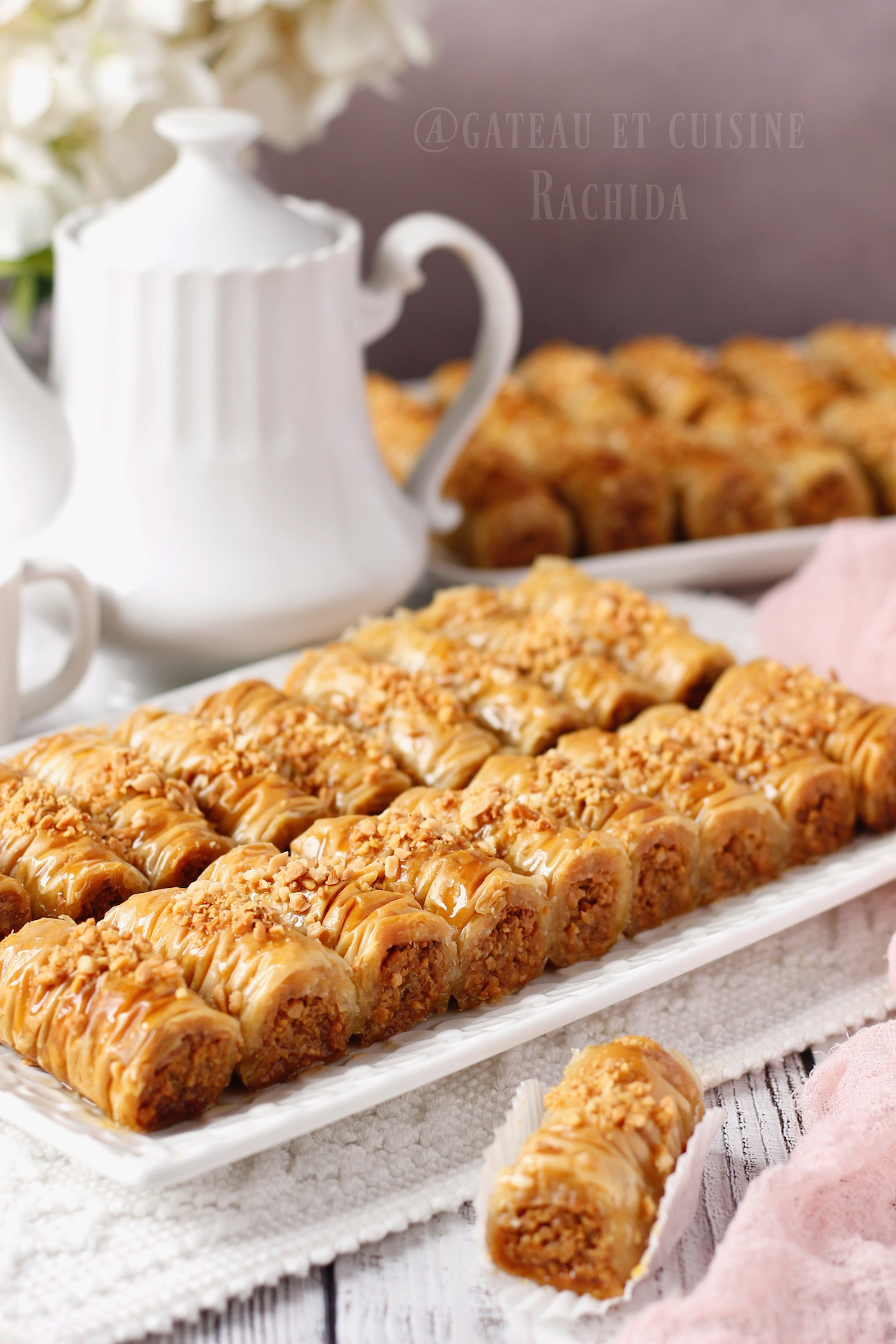
Whether for Eid al-Fitr, during Ramadan, or for any other occasion, baklava rolls or baklawa, as it’s called in the Maghreb, is a highly appreciated and essential pastry.
If you’ve never tasted it, baklava is a Turkish pastry made of thin sheets of phyllo dough, generously brushed with ghee (clarified butter) or alternatively with melted butter. It’s filled with almonds, pistachios, or other nuts, flavored with cinnamon, then drizzled with a sweet syrup or honey. It’s also found in several neighboring countries, such as Greece, Syria, and Lebanon. In North Africa, it is made exclusively with almonds and, traditionally, with homemade dough that is rolled out very thinly and layered into sheets.
Traditionally, baklava is cut into diamond or square shapes, but the rolled version is also very popular. It’s delicious to savor with a glass of mint tea or accompanied by a good coffee.
The homemade baklava recipe is quite easy to prepare, as store-bought phyllo dough is generally used, which takes much less time than preparing and rolling it out very thinly yourself.
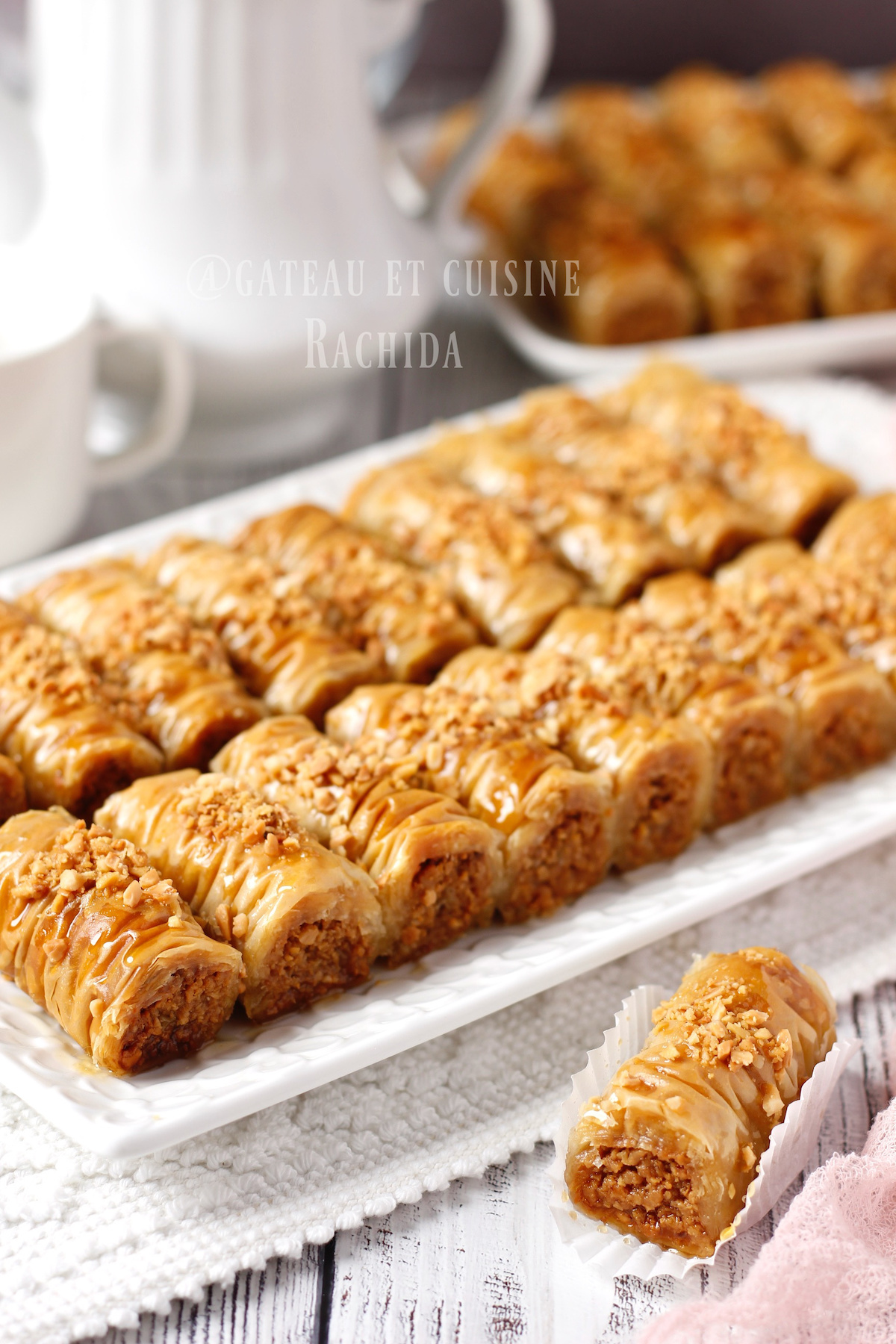
Table of Contents
Tips and tricks
The filling: The ingredients for baklava are quite simple. I chose to use a 100% almond filling, but you can easily replace them with a mixture of almonds and pistachios, only pistachios, or even walnuts, anything is possible. The essential thing is to use quality dried fruits.
The phyllo dough: Phyllo dough is very fragile and, depending on the brand, some sheets may be cut or damaged inside the package. Unroll them gently on a clean towel. Generally, a 470 g (16.5 oz) package contains about 15 sheets.
You will need 2 sheets of filo pastry to form a long roll, which you will then cut into several pieces of baklava. For my part, I cut each roll into 4 pieces.
Number of rolls: With my quantities, you can make 8 to 10 rolls depending on the amount of filling you use. As I had some phyllo dough left over, you can, if you wish, buy only one package and reduce the amount of almonds to 400g (14 oz). That said, I advise you to plan for a bit more dough, as some sheets might be too damaged to use.
If you come across a slightly torn sheet, simply place it inside the roll, it won’t cause any problem.
Smooth or Crinkled Baklava
I chose to crinkle the rolls for a nice visual effect, but you can very well leave them smooth if you prefer. For this, you’ll need a stick a bit longer than the width of the sheets, which will serve to form and crinkle the sheets of the roll.
It should stick out from the sides of the roll when you’ve rolled up the sheets. As I didn’t have one, I improvised with two large rigid plastic straws, placed end to end then tightly wrapped in plastic wrap. You can also use a wooden stick of this kind.
Honey or syrup: I prefer honey, as the baklava stays crispy longer and it’s ready to use. You can choose the one you like, and its quality will depend on individual means. You can use real bee honey or honey prepared from sugar.
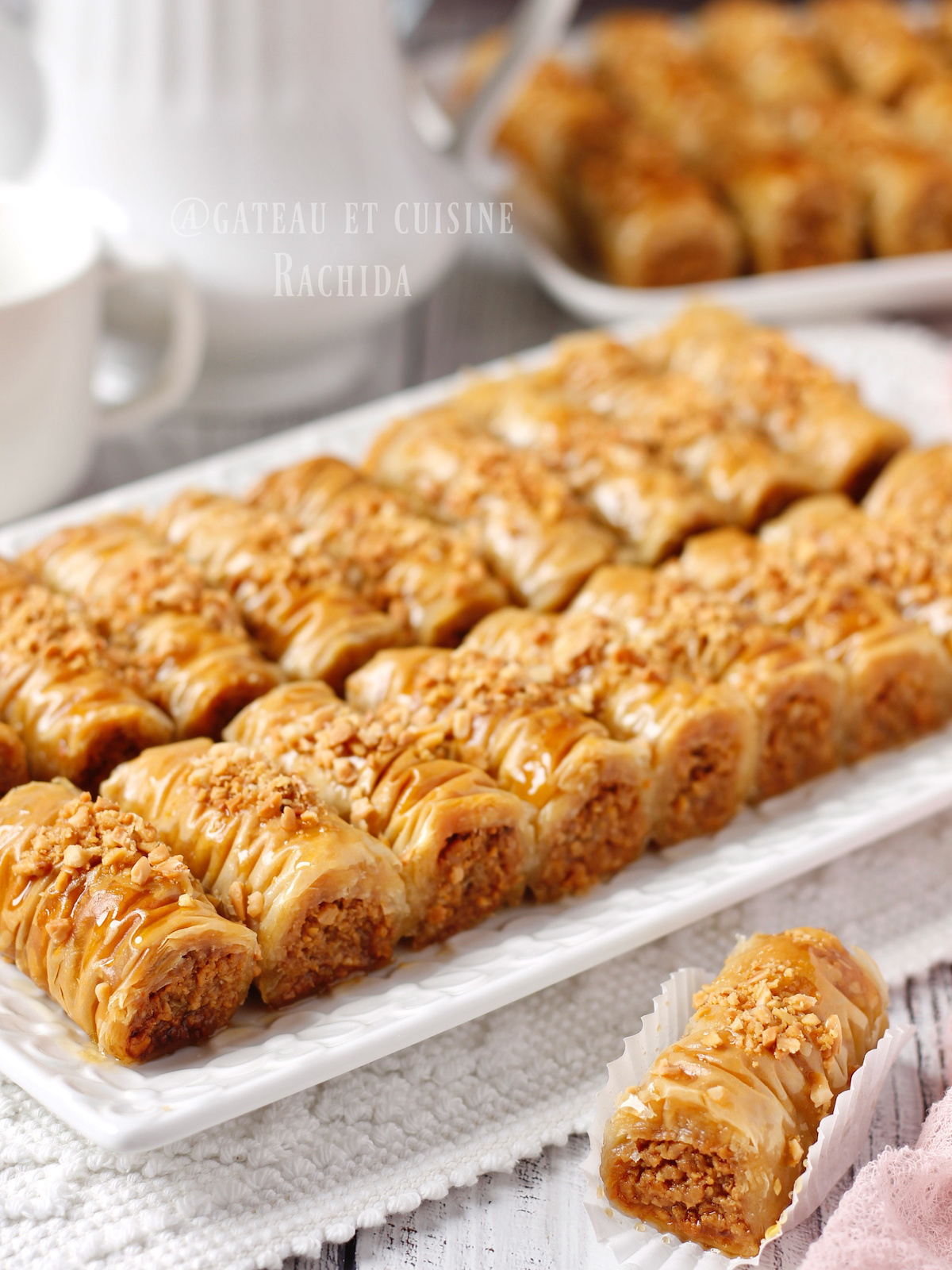
Ingredients:
NB: Find the recipe card that you can print at the end of the article.
See the tips above to adjust the quantities
For 32 baklava rolls
- 500 g almonds (17.6 oz)
- 1 teaspoon cinnamon
- 4 tablespoons orange blossom water (more or less depending on consistency)
- 1 teaspoon honey
- 2 packages of phyllo dough (470 g each, the ones I used) (16.6 oz per package). You will have leftover dough; see the tips above. I used 16 sheets.
- 400 g melted and clarified butter (14 oz)
- 480 g honey (17 oz)
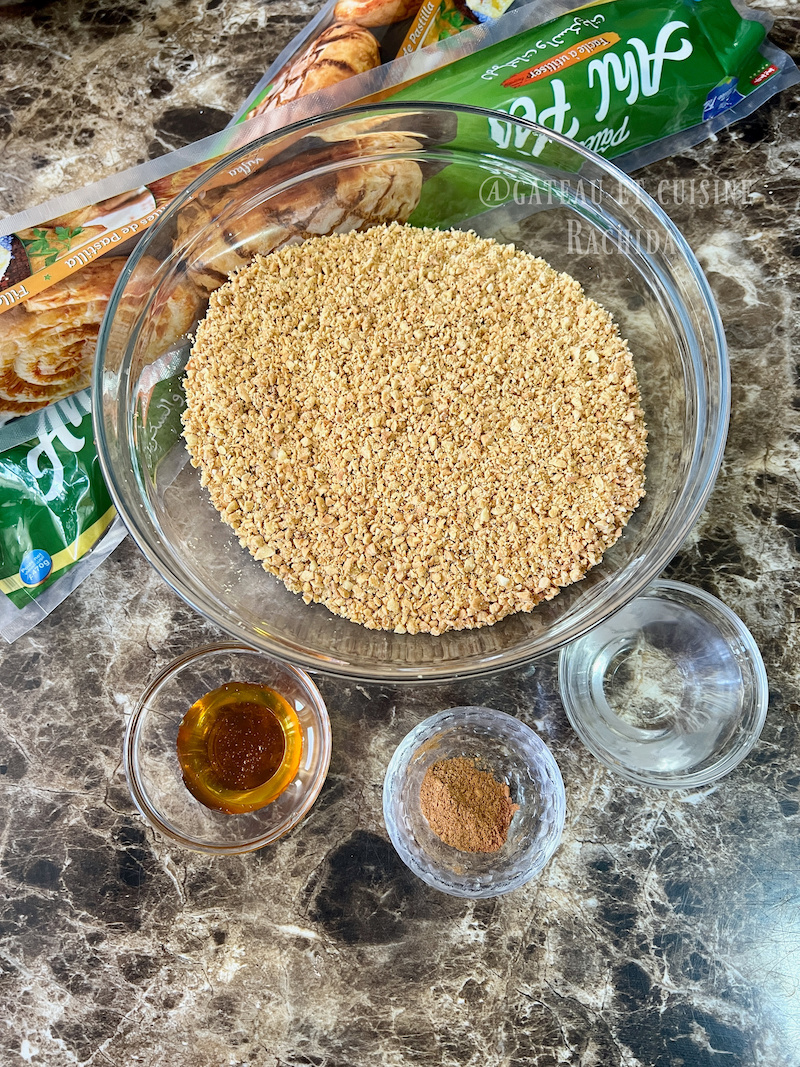
Preparation steps :
Blanching the almonds
Cover the almonds with water and bring to a boil until the skin easily comes off. Don’t boil them too long.
Pour them into a colander and peel them. To make it easier, you can wrap them in a clean cloth and rub between your hands. Do this the day before or a few hours before toasting them.
Toast the almonds in hot oil over medium heat and let them cool before grinding them into fairly fine grains.
In a large bowl, mix the crushed almonds with cinnamon, honey, and orange blossom water.
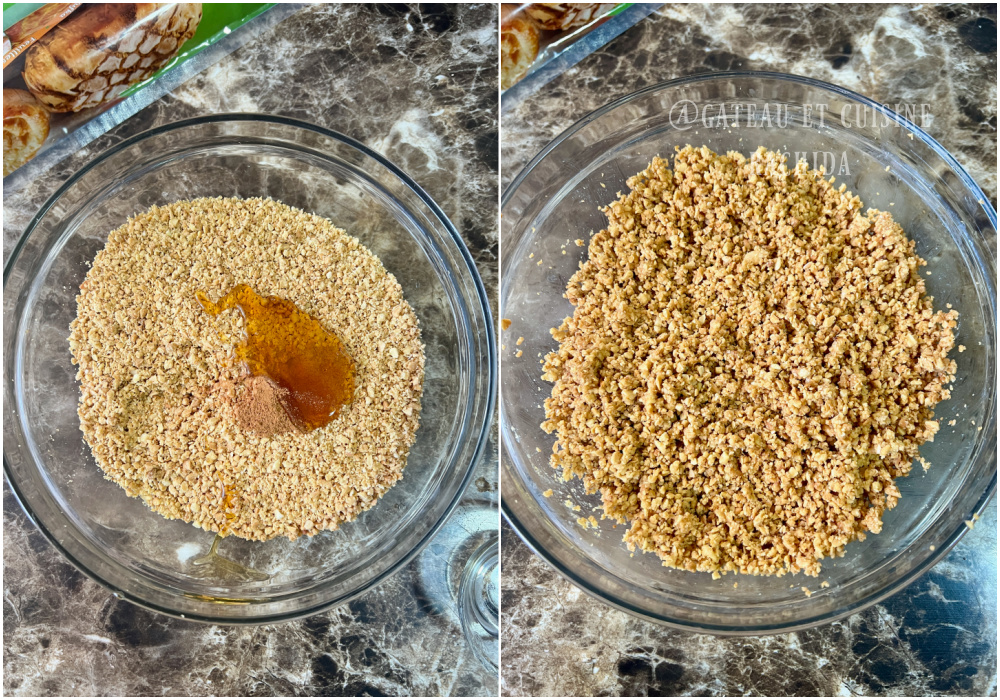
Preparing the baklavas
Melt the butter and clarify it, which means letting it rest a bit after removing the foam until the milk settles at the bottom, then pour only the butter into another saucepan.
Carefully unroll the filo pastry sheets on a clean cloth and remove 2 at a time. Roll the rest in their plastic and in a clean towel to prevent them from drying out during preparation.
Place a sheet of filo pastry on the work surface and brush it with a little butter. Place the 2nd sheet on top and brush it with butter as well, as you can see in the image below.
Place the slightly longer stick about 11 cm / 4.3 inch from the edge, widthwise, then fold the phyllo dough over it. Brush with a little butter.
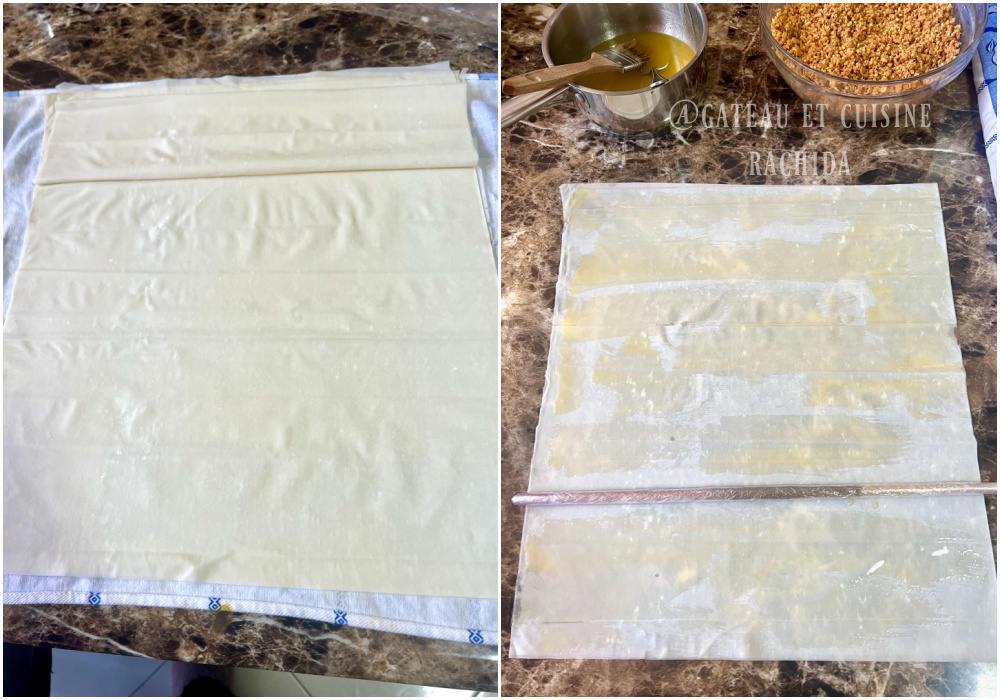
Put some almonds evenly on this border, against the stick, leaving 1 cm / 0.4 inches empty on each side (see step image).
Roll gently, tightening well around without pressing on the pastry.
Slightly crumple the formed filo pastry roll by gently pushing both ends towards the center to create the pleated effect.
Hold it this way with your hands and place it in the mold, preferably with the same width as the roll to keep the pleated effect (26 cm / 10.2 inches for me).
Gently remove the stick by pushing the roll into the mold.
Repeat until you run out of sheets and filling.
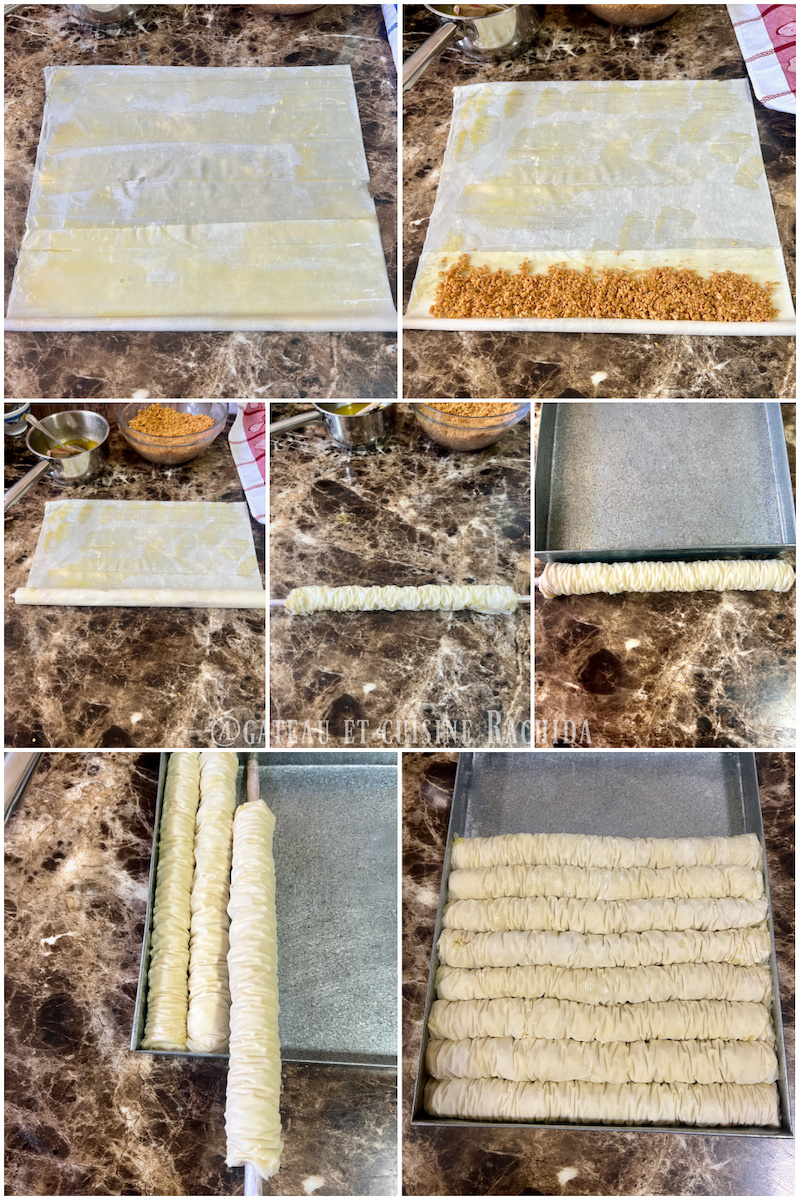
Cut each roll into identical sized pieces, according to your preference (usually 4 to 5 pieces per roll).
Brush the entire surface well with melted butter.
Baking
Bake at 180°C (356°F) with static heat for about 40 minutes, until the baklava is golden brown. Check from time to time towards the end.
Meanwhile, gently heat the honey to liquefy it. If it’s already liquid, this isn’t necessary. It should be poured cold over the hot baklava.
As soon as it comes out of the oven, drizzle the hot baklava with honey to soak it well.
Decorate the top of each baklava, in the center, with some crushed almond set aside from the filling, or by adding a bit more, as I did.
Let it absorb for at least 6 hours, ideally overnight. 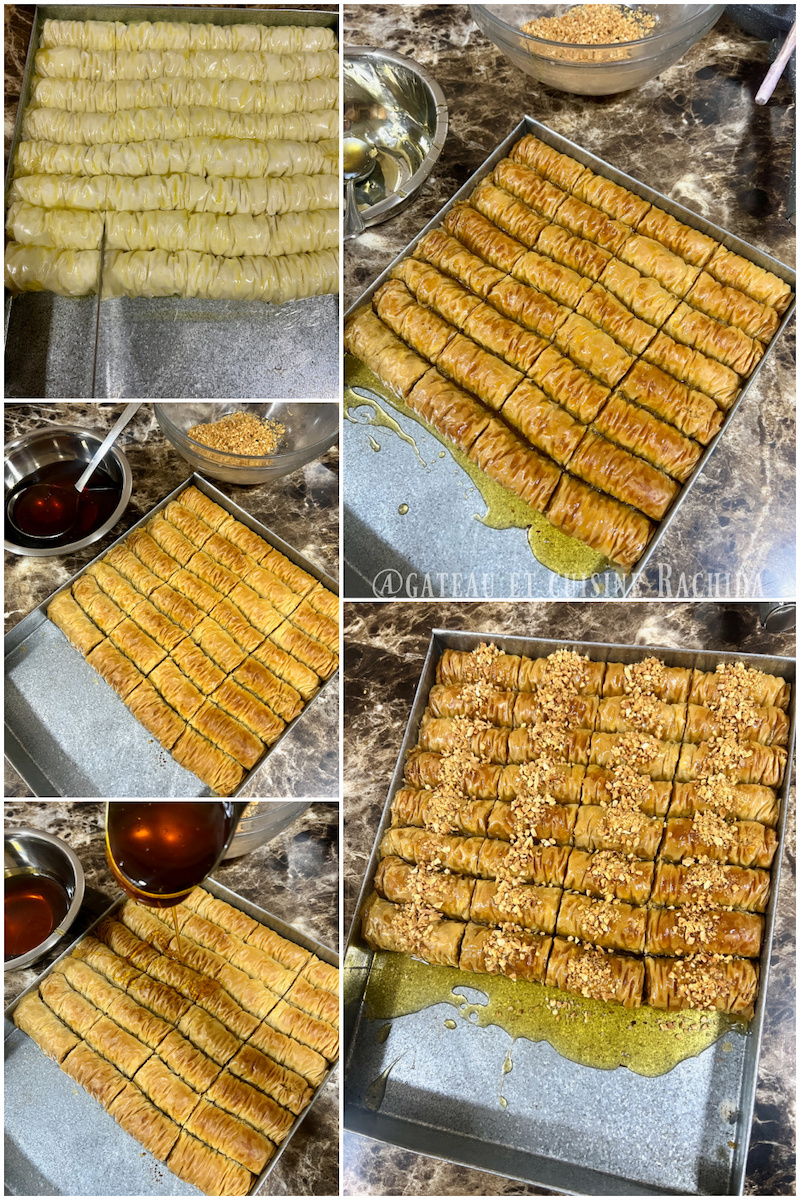
After this time, run a knife between each baklava before removing them and placing them in paper cases.
Tips of storage :
You can store them for up to a week in an airtight container at room temperature. They will keep their crispiness if they are well soaked in honey.
If you prepare a large quantity, you can also freeze them. Take out the amount you want and let them thaw at room temperature.
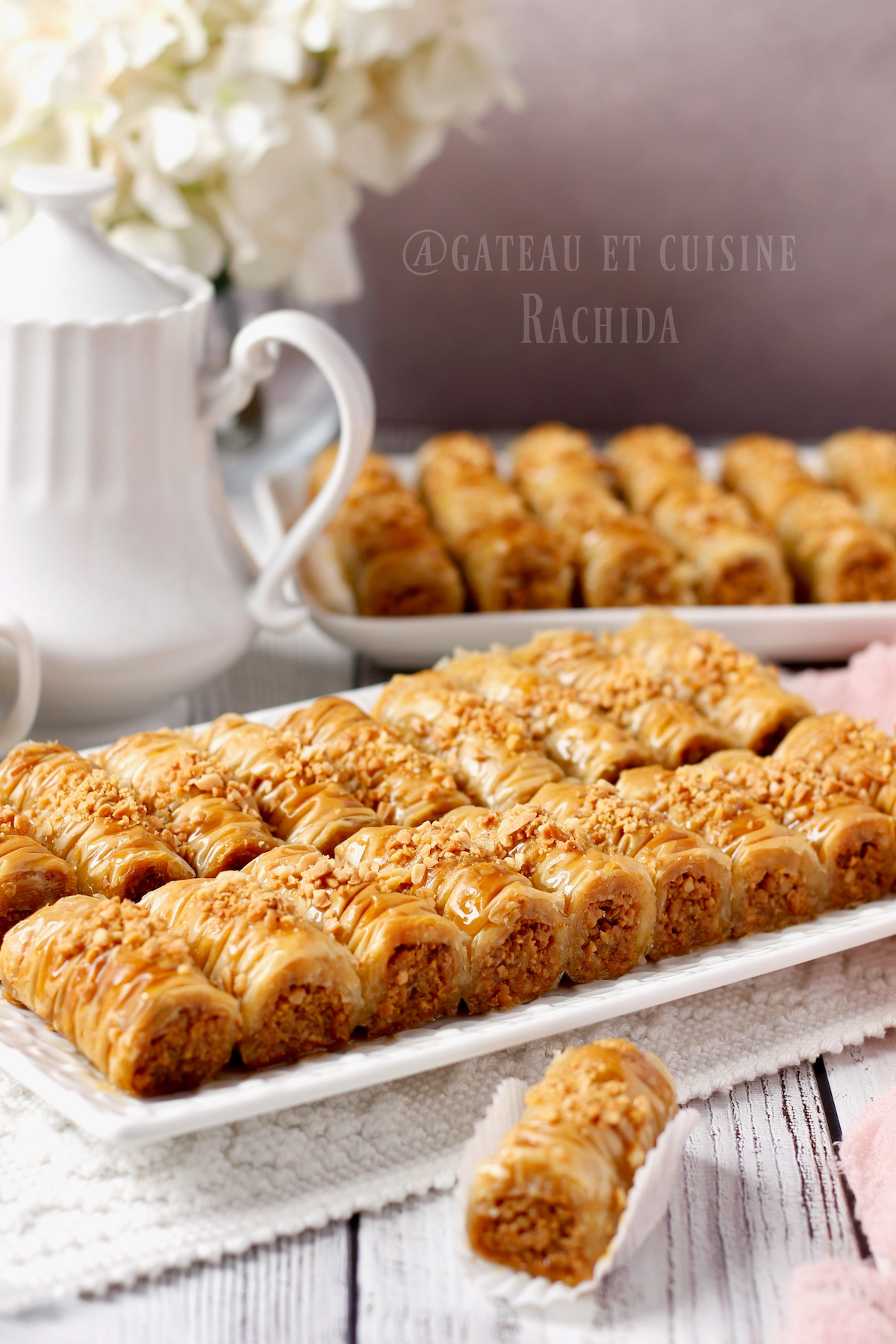
Other recipes you might like
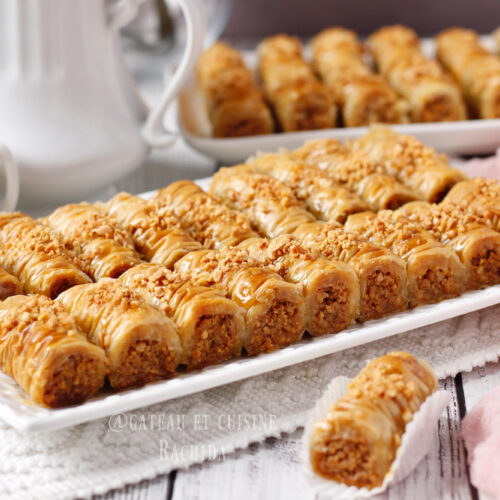
INGREDIENTS
- 500 g almonds 17.6 oz
- 1 teaspoon cinnamon
- 4 tablespoons orange blossom water more or less depending on consistency
- 1 teaspoon honey
- 2 packages of phyllo dough 470 g each, the ones I used (16.6 oz per package). You will have leftover dough; see the tips above. I used 16 sheets.
- 400 g melted and clarified butter 14 oz
- 480 g honey 17 oz
PREPARATION
- See the tips in the article to adjust the quantities and visualize the steps with images.
Blanching the almonds
- Cover the almonds with water and bring to a boil until the skin easily comes off. Don't boil them too long.
- Pour them into a colander and peel them. To make it easier, you can wrap them in a clean cloth and rub between your hands. Do this the day before or a few hours before toasting them.
- Toast the almonds in hot oil over medium heat and let them cool before grinding them into fairly fine grains.
- In a large bowl, mix the crushed almonds with cinnamon, honey, and orange blossom water.
Preparing the baklavas
- Melt the butter and clarify it, which means letting it rest a bit after removing the foam until the milk settles at the bottom, then pour only the butter into another saucepan.
- Carefully unroll the filo pastry sheets on a clean cloth and remove 2 at a time. Roll the rest in their plastic and in a clean towel to prevent them from drying out during preparation.
- Place a sheet of filo pastry on the work surface and brush it with a little butter. Place the 2nd sheet on top and brush it with butter as well, as you can see in the image below.
- Place the slightly longer stick about 11 cm / 4.3 inch from the edge, widthwise, then fold the phyllo dough over it. Brush with a little butter.
- Put some almonds evenly on this border, against the stick, leaving 1 cm / 0.4 inches empty on each side (see step image).
- Roll gently, tightening well around without pressing on the pastry.
- Slightly crumple the formed filo pastry roll by gently pushing both ends towards the center to create the pleated effect.
- Hold it this way with your hands and place it in the mold, preferably with the same width as the roll to keep the pleated effect (26 cm / 10.2 inches for me).
- Gently remove the stick by pushing the roll into the mold.
- Repeat until you run out of sheets and filling.
- Cut each roll into identical sized pieces, according to your preference (usually 4 to 5 pieces per roll).
- Brush the entire surface well with melted butter.
Baking
- Bake at 180°C (356°F) with static heat for about 40 minutes, until the baklava is golden brown. Check from time to time towards the end.
- Meanwhile, gently heat the honey to liquefy it. If it's already liquid, this isn't necessary. It should be poured cold over the hot baklava.
- As soon as it comes out of the oven, drizzle the hot baklava with honey to soak it well.
- Decorate the top of each baklava, in the center, with some crushed almond set aside from the filling, or by adding a bit more, as I did.
- Let it absorb for at least 6 hours, ideally overnight.
- After this time, run a knife between each baklava before removing them and placing them in paper cases.
Thank you for visiting my blog and for your comments.
You can also follow me on my youtube channel
